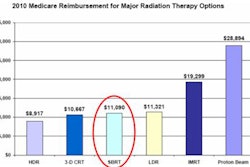Intraoperative radiation therapy (IORT) combined with chemotherapy appears to be a promising treatment for patients who have undergone surgical resection of pancreatic cancer, according to a report published in the International Journal of Radiation Oncology, Biology, Physics.
A multi-institutional team of radiation oncologists reached this opinion after analyzing the medical records of 210 patients who received IORT for pancreatic cancer at 12 cancer treatment centers in Japan.
The research team retrospectively reviewed outcomes data of patients who were treated with gross complete resection followed by IORT with or without external-beam radiation therapy (EBRT) to evaluate the efficacy and safety of IORT for resectable pancreatic cancer. The patients received treatment between 2000 and 2006. Slightly more than half of the group also underwent various chemotherapy treatments (IJROBP, July 1, 2010, Vol. 77:3, pp. 734-742).
IORT doses ranged from 20 to 30 Gy, and EBRT doses ranged from 20 to 60 Gy, delivered as a single fraction of 1.8 to 2 Gy five days a week. Approximately 30% of the patients received both IORT and EBRT treatments.
Patients who experienced the highest levels of toxicity were treated with a 30-Gy IORT dose, whereas patients who received doses of approximately 25 Gy tolerated the treatment reasonably well. Seven patients experienced late gastrointestinal toxicities rated as grade 3 to 4 on the National Cancer Institute Common Toxicity Criteria (NCI-CTC) scale, representing 3.3% of the total.
When the analysis was conducted in 2009, 70% of the patients had disease recurrence, and 148 patients had died during the analysis period, 90% from pancreatic cancer. A total of 12 patients, or 5.7%, achieved local control and survived for more than five years following treatment. The incidence of local control was highest in patients who had R0 resection treated with 25 Gy IORT and EBRT. The overall two-year local control rate was 83.7% for all 210 patients.
For the majority of patients, the researchers found no significant difference in local control between patients treated with IORT alone and the combination radiotherapy treatment. However, patients who underwent an R1 resection who had the combined treatment had a 90% incidence of local control, compared to 68% in patients treated with 25-Gy IORT alone. For this group, the researchers suggested that combined IORT and EBRT treatment may be most appropriate, but could not verify this because the impact of the different types of chemotherapy treatments could not be analyzed due to small sample sizes.
Lead author Kazuhiko Ogawa, MD, a radiation oncologist at the University of the Ryukyus in Okinawa, and colleagues believe that these findings indicate that IORT treatment yields an excellent local control rate for resected pancreatic cancer. With this patient cohort, when chemotherapy was added, survival outcomes were better than with patients who only had radiotherapy treatments, they noted.
The researchers believe that IORT is a promising treatment, but note that its optimal use, particularly with respect to dose and EBRT combination strategies, is not yet defined. They recommend that prospective clinical trials be implemented.
By Cynthia E. Keen
AuntMinnie.com staff writer
July 13, 2010
Related Reading
Chemoradiation after pancreatic surgery adds months to survival, January 28, 2010
Few improvements in pancreatic cancer treatment in three decades, July 29, 2009
Extra therapy a plus after pancreatic cancer surgery, January 22, 2007
Copyright © 2010 AuntMinnie.com



















